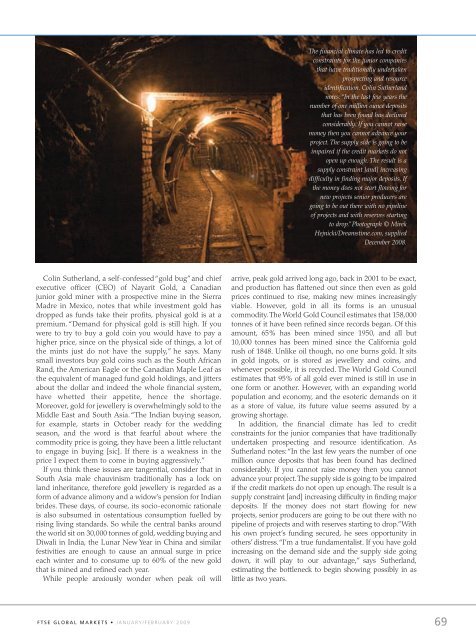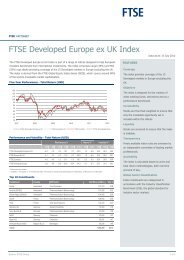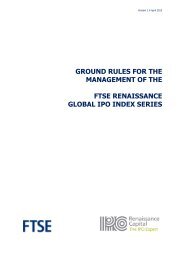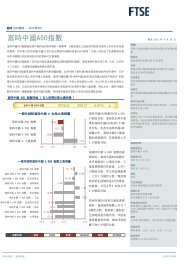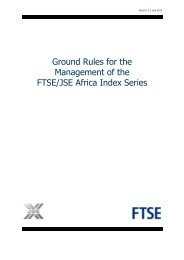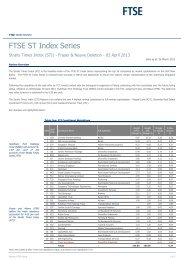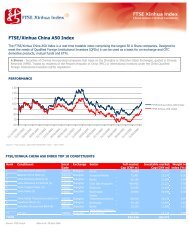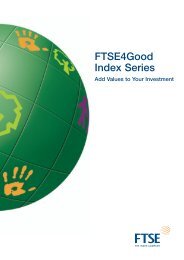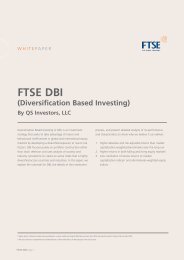You also want an ePaper? Increase the reach of your titles
YUMPU automatically turns print PDFs into web optimized ePapers that Google loves.
Colin Sutherland, a self-confessed“gold bug”and chief<br />
executive officer (CEO) of Nayarit Gold, a Canadian<br />
junior gold miner with a prospective mine in the Sierra<br />
Madre in Mexico, notes that while investment gold has<br />
dropped as funds take their profits, physical gold is at a<br />
premium. “Demand for physical gold is still high. If you<br />
were to try to buy a gold coin you would have to pay a<br />
higher price, since on the physical side of things, a lot of<br />
the mints just do not have the supply,” he says. Many<br />
small investors buy gold coins such as the South African<br />
Rand, the American Eagle or the Canadian Maple Leaf as<br />
the equivalent of managed fund gold holdings, and jitters<br />
about the dollar and indeed the whole financial system,<br />
have whetted their appetite, hence the shortage.<br />
Moreover, gold for jewellery is overwhelmingly sold to the<br />
Middle East and South Asia.“The Indian buying season,<br />
for example, starts in October ready for the wedding<br />
season, and the word is that fearful about where the<br />
commodity price is going, they have been a little reluctant<br />
to engage in buying [sic]. If there is a weakness in the<br />
price I expect them to come in buying aggressively.”<br />
If you think these issues are tangential, consider that in<br />
South Asia male chauvinism traditionally has a lock on<br />
land inheritance, therefore gold jewellery is regarded as a<br />
form of advance alimony and a widow’s pension for Indian<br />
brides. These days, of course, its socio-economic rationale<br />
is also subsumed in ostentatious consumption fuelled by<br />
rising living standards. So while the central banks around<br />
the world sit on 30,000 tonnes of gold, wedding buying and<br />
Diwali in India, the Lunar New Year in China and similar<br />
festivities are enough to cause an annual surge in price<br />
each winter and to consume up to 60% of the new gold<br />
that is mined and refined each year.<br />
While people anxiously wonder when peak oil will<br />
F T S E G L O B A L M A R K E T S • J A N U A R Y / F E B R U A R Y 2 0 0 9<br />
The financial climate has led to credit<br />
constraints for the junior companies<br />
that have traditionally undertaken<br />
prospecting and resource<br />
identification. Colin Sutherland<br />
notes: “In the last few years the<br />
number of one million ounce deposits<br />
that has been found has declined<br />
considerably. If you cannot raise<br />
money then you cannot advance your<br />
project. The supply side is going to be<br />
impaired if the credit markets do not<br />
open up enough. The result is a<br />
supply constraint [and] increasing<br />
difficulty in finding major deposits. If<br />
the money does not start flowing for<br />
new projects senior producers are<br />
going to be out there with no pipeline<br />
of projects and with reserves starting<br />
to drop.” Photograph © Mirek<br />
Hejnicki/Dreamstime.com, supplied<br />
December 2008.<br />
arrive, peak gold arrived long ago, back in 2001 to be exact,<br />
and production has flattened out since then even as gold<br />
prices continued to rise, making new mines increasingly<br />
viable. However, gold in all its forms is an unusual<br />
commodity.The World Gold Council estimates that 158,000<br />
tonnes of it have been refined since records began. Of this<br />
amount, 65% has been mined since 1950, and all but<br />
10,000 tonnes has been mined since the California gold<br />
rush of 1848. Unlike oil though, no one burns gold. It sits<br />
in gold ingots, or is stored as jewellery and coins, and<br />
whenever possible, it is recycled. The World Gold Council<br />
estimates that 95% of all gold ever mined is still in use in<br />
one form or another. However, with an expanding world<br />
population and economy, and the esoteric demands on it<br />
as a store of value, its future value seems assured by a<br />
growing shortage.<br />
In addition, the financial climate has led to credit<br />
constraints for the junior companies that have traditionally<br />
undertaken prospecting and resource identification. As<br />
Sutherland notes:“In the last few years the number of one<br />
million ounce deposits that has been found has declined<br />
considerably. If you cannot raise money then you cannot<br />
advance your project.The supply side is going to be impaired<br />
if the credit markets do not open up enough. The result is a<br />
supply constraint [and] increasing difficulty in finding major<br />
deposits. If the money does not start flowing for new<br />
projects, senior producers are going to be out there with no<br />
pipeline of projects and with reserves starting to drop.”With<br />
his own project’s funding secured, he sees opportunity in<br />
others’ distress.“I’m a true fundamentalist. If you have gold<br />
increasing on the demand side and the supply side going<br />
down, it will play to our advantage,” says Sutherland,<br />
estimating the bottleneck to begin showing possibly in as<br />
little as two years.<br />
69


